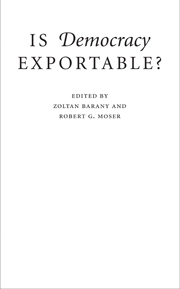Book contents
- Frontmatter
- Contents
- Contributors
- Acknowledgments
- Introduction
- A MORAL IMPERATIVE?
- STRUCTURAL PRECONDITIONS
- 2 Re-Integrating the Study of Civil Society and the State
- 3 Encountering Culture
- 4 Does Democracy Work in Deeply Divided Societies?
- 5 Democracy, Civil Society, and the Problem of Tolerance
- INSTITUTIONS AND PROCESSES
- Conclusion: Is Democracy Exportable?
- Bibliography
- Index
2 - Re-Integrating the Study of Civil Society and the State
Published online by Cambridge University Press: 05 June 2012
- Frontmatter
- Contents
- Contributors
- Acknowledgments
- Introduction
- A MORAL IMPERATIVE?
- STRUCTURAL PRECONDITIONS
- 2 Re-Integrating the Study of Civil Society and the State
- 3 Encountering Culture
- 4 Does Democracy Work in Deeply Divided Societies?
- 5 Democracy, Civil Society, and the Problem of Tolerance
- INSTITUTIONS AND PROCESSES
- Conclusion: Is Democracy Exportable?
- Bibliography
- Index
Summary
Today civil society is a hot topic both inside the academy and out. In the decades after the Second World War, scholars focused primarily on economic development, institutional arrangements, and long-term trajectories of historical change when trying to explain whether or not democracy existed in particular countries. But, beginning in the 1990s, those interested in the study and promotion of democracy rediscovered the importance of civil society. Although one can find almost as many definitions of civil society as there are discussions of it, the term commonly refers to all voluntary associations that exist below the level of the state, but above the family. As one well known treatment put it, “civil society is the realm of organizational life that is open, voluntary, self-generating, at least partially self-supporting, autonomous from the state, and bound by a legal order or set of shared rules” (Diamond 1999: 221). Civil society, in other words, encompasses a wide range of informal and formal societal relationships, networks, and interactions, including everything from bowling clubs to church groups, reading circles to NGOs (Bermeo 2000; Encarción 2003: 24; Foley, Edwards, and Diani 2001).
This renewed interest in civil society was prompted by both scholarly trends and real world events. In the former category, the publication of several path-breaking works on civil society, particularly Robert Putnam's Making Democracy Work (1993), excited a social scientific community constantly on the lookout for new variables and paradigms.
- Type
- Chapter
- Information
- Is Democracy Exportable? , pp. 37 - 56Publisher: Cambridge University PressPrint publication year: 2009
- 6
- Cited by



